Issue number 123
Newsletter Summer 2024
Summer 2024 Newsletter. edited by Cynthia Brown
Welcome to the latest edition of the LAHS Newsletter. Contributions to future editions of the Newsletter are as always welcome at any time. These can be emailed to the Newsletter editor, Cynthia Brown, at newsletter@lahs.org.uk.
ADDITION TO THE LAHS LECTURE PROGRAMME for 2023 - 24
Thursday 6 June 2024, 7.30 pm, Leicester Museum and Art Gallery, Leicester, LE1 7EA “Dropped from hell into heaven”: internment of sick and wounded prisoners of war in Switzerland during World War One
Dr Susan Barton, Lord Mayor of Leicester for 2023 – 24, will talk about her work on Switzerland and World War I - with a Leicester angle. For more details see “Dropped from hell into heaven”: Internment of sick and wounded prisoners of war in Switzerland during World War One. - LAHS.
LECTURE PROGRAMME FOR 2024 - 25 – PLEASE NOTE THE CHANGE OF VENUE
New Walk Museum, our usual venue for LAHS lectures, will be unavailable for some time due to building work. These lectures and the LAHS AGM will therefore take place in the Rattray Lecture Theatre at the University of Leicester at 7.30 pm. Doors open 7 pm; refreshments available in advance of the lecture.
Thursday 26 September 2024
Scarborough Lecture
Topic and speaker to be confirmed
Thursday 17 October 2024
All Quiet on the Leicester Front?: the US military race disturbances of 1944
Vincent Holyoak
This lecture is part of Black History Month 2024.
Thursday 14 November 2024
LAHS ANNUAL GENERAL MEETING – FOLLOWED BY LECTURE
Church people and social change in 19th century Leicestershire
Nick Miller
Thursday 12 December 2024
Leicester: an Anglo-Saxon diocese
Thomas Vare
LAHS NEWS
PUBLIC HERITAGE FUND
The LAHS Public Heritage Fund is pleased to announce a grant to cover the production of a touring exhibition celebrating the 50th anniversary of the founding of the Leicestershire and Rutland Family History Society (LRFHS) in 1974. It will include a timeline of these years and look at genealogical research developments during the last half-century. It will also feature images of local life in 1974, and include stories of family history research from LRFHS members. See www.lrfhs.org.uk for more information about LRFHS and its activities.
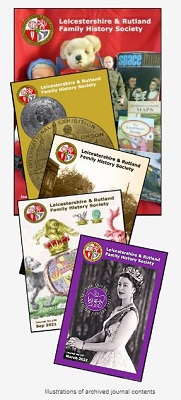
The LAHS Public Heritage Fund provides grants to individuals and history and heritage societies and projects within Leicestershire and Rutland which will enable engagement with the general public and the presentation of research to wider audiences. Non-members of LAHS are eligible to apply. Applications are considered four times per calendar year. If you would like to apply for a grant, the next funding round ends on 19 July. For more information, visit
www.lahs.org.uk/grants/public-heritage-fund.
IF YOU ARE NOT ALREADY A MEMBER OF LAHS - WHY NOT JOIN?
Membership of LAHS offers a wealth of benefits, including copies of our two annual publications, the Leicestershire Historian and the Transactions of the Society. Members can access our current publications in digital format, and previous publications are available through the Archaeological Data Service. Regular Newsletters and updates on the activities of LAHS are also circulated by email. Very importantly, membership offers a forum for those interested in researching and learning about different aspects of Leicestershire and Rutland's past.
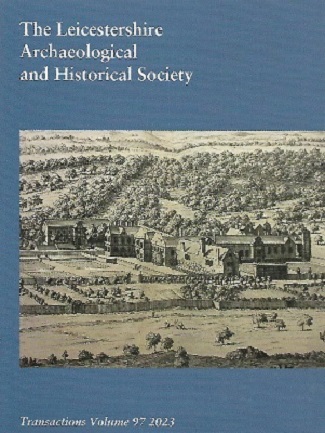
You will also be entitled to vote at our AGM and help shape the future of the Society. Free student membership is available, and carries the same benefits as Individual membership with the exception of copies of the Society's two annual publications and a vote at the AGM. You can join LAHS on our website at Membership application - LAHS by completing an online application, or printing off a paper copy to send to our Hon. LAHS Membership Secretary Gillian Rawlins, c/o LAHS, The Guildhall, Guildhall Lane, Leicester, LE1 5F. If you have any queries please do contact her at membership@lahs.org.uk. If you have received this Newsletter by post and do not have access to the Internet, please write to her instead at the same address. You will be very welcome!
OTHER NEWS
FREE PDFs FROM HEART OF ALBION PRESS
The following are all free from the home page of Heart of Albion website at Heart of Albion Press (hoap.co.uk) or by clicking on the links below.
An Index of Leicestershire Lore - https://www.hoap.co.uk/an_index_of%20_leicestershire_lore.pdf
Bob Trubshaw of Heart of Albion Press writes that: ‘Back in 2004 I wrote and published a book called Leicestershire Legends Retold by Black Annis. It is still available as a free PDF at www.hoap.co.uk/leics_legends.pdf. As part of the preparation of that book I re-read every source I had for Leicestershire folklore. Many of these books were published without an index, so I typed out brief notes. Slightly confusingly they are in order of location, so are effectively a gazetteer of local lore. I have compiled this “index” of Leicestershire lore and made it available as a free PDF, just in case it is of interest or use to other researchers and authors. There are separate sections on 'lore' and on ghosts, followed by a bibliography.
Understanding Leicestershire and Rutland Place-names
This book by Jill Bourne is now out of print but can be accessed at UL&RPN (hoap.co.uk).
Swithland Slate Headstones - this is a revised edition by LAHS member David Lee - swithland_slate_headstones.pdf (hoap.co.uk).
LEICESTERSHIRE COUNTY COUNCIL – HARBOROUGH MUSEUM
A family friendly exhibition, ‘Harborough at Work: earning a living in a Ladybird world’, looks at Ladybird Books to consider how occupations and attitudes have changed since the publication of the first title over 60 years ago. Original illustrations and museum objects are on display alongside community portrait photos and stories, and a creative response to the exhibition co-curated with the local community will also be displayed from September 2024. The exhibition runs until 1 February 2025. The museum is located in Adam and Eve Street, Market Harborough, LE16 7LT, and is open Tuesday – Friday from 10 am to 6 pm; Saturday from 10 am to 4 pm. Further details at Harborough at Work: Earning a Living in a Ladybird World | Leicestershire County Council.
LOUGHBOROUGH CARILLON IMPROVEMENTS
Charnwood Borough Council has worked with the Carillon Memorial Trust to secure around £100,000 from the UK Shared Prosperity Fund to make improvements to Loughborough’s historic Carillon Tower and War Memorial Museum. The project will focus on the ground floor of the tower, with new display cabinets and more modern ways of presenting information. The work should start later this year and is expected to be completed by Easter 2025. Carillion recitals will continue every Thursday and Sunday between 1pm and 2pm throughout the summer. The 150 feet high Loughborough Carillon is Grade II listed. It was built after the First World War to commemorate the men of Loughborough who died in the conflict. It carries the names of 800 men who died in both World Wars and other conflicts, and was completed in 1923. A total of 47 bells is housed in the Carillon Tower, cast at Loughborough based John Taylor and Co Bell Foundry, the last major bell foundry in Britain. For more information about the proposed improvements - £100k investment to improve Loughborough Carillon Museum - Latest News - News Updates - Charnwood Borough Council.
LEICESTER MUSEUM AND ART GALLERY – 175th ANNIVERSARY
Leicester Museum and Art Gallery in New Walk, Leicester will be celebrating its 175th anniversary in June 2024. It was established in 1849 when the Leicester Literary and Philosophical Society presented its collection of 10,000 objects to the town, and was one of the first municipal museums in the country. The building was designed by Leicestershire architect Joseph Hansom as the Nonconformist Leicester Proprietary School, which opened in 1837. There is an online exhibition about the history of the Museum at History of Leicester Museum & Art Gallery – Leicester Museums.
NEWARKE HOUSES MUSEUM, LEICESTER
A reminder that ‘Popping to the Shops’, an exhibition at Newarke Houses Museum, Leicester has been extended due to popular demand, and will now remain on display until Sunday 1 September 2024. The exhibition features the people of the Narborough Road, one of the most ethnically diverse roads in the country, and offers the opportunity to learn more about their experiences and memories. A number of new museum objects have been collected from the shops, and are displayed in the exhibition. A local photographer has worked with the people and museum team to produce the new photographs on display. See Whats On – Leicester Museums for more details.
STONEYGATE CONSERVATION AREA SOCIETY
The new website of Stoneygate Conservation Area Society is now up and running, with pages on Stoneygate’s history along with short biographies of notable local people. There is also a page featuring the wildlife of the area – and back copies of the Society’s newsletter will be added over the coming months. The Conservation Area, which also includes part of Clarendon Park and Knighton and crosses three City Council wards, is made up of properties representing nearly two hundred years of the City’s history. The oldest building (`The Firs’ at 223 London Road) dates from the 1820s. The newest (the £20 million South Lodge Care Home at 307 London Road) opened in 2010 but retains the façade of an earlier house built in the 1870s as a centrepiece. You can visit the website at Conservation Area - Stoneygate Conservation Area Society.
GEORGE EDMUND STREET – RECENT VICTORIAN SOCIETY PUBLICATION
The latest book in the Victorian Society’s Architects Series, George Edmund Street by Geoff Brandwood, Peter Howell and Peter Taylor, has recently been published. Its co-author Geoff Brandwood, a prominent architect and writer, served on the LAHS Committee as Hon Secretary (Minutes) from 1979/80, and then as Newsletter Editor from 1981 - 82 to 1984 - 85. This is the first monograph of George Edmund Street, a prolific High Victorian architect of churches and other buildings, the best known of which is the Royal Courts of Justice (the Law Courts). He was renowned for always completing all his own drawings personally, to the frustration of his pupils and assistants, including Philip Webb and Norman Shaw who successively became his chief assistant before branching out on their own. Geoff Brandwood, a former LAHS Committee member who died suddenly in November 2021, was the author of monographs on Sharpe, Paley & Austin and on Temple Moore. He was a former chairman of the Victorian Society. Co-author Peter Howell is Honorary Research Fellow at Royal Holloway, University of London and a former chairman of the Victorian Society. The late Peter Taylor, co-author, was a researcher and photographer of architectural history as well as a member of the Victorian Society. To purchase a copy go to The Victorian Society - Victorian Society books and journals (UK) (beaconforms.com).
ARCHAEOLOGY
UNIVERSITY OF LEICESTER ARCHAEOLOGICAL SERVICES (ULAS)
Dr Gavin Speed and Tim Higgins report on recent fieldwork by ULAS: Over early Spring 2024, ULAS have had been busy on two large excavations, along with several smaller projects. Our team have been hampered by the very wet winter weather, with flooded sites often slowing and/or preventing work. All have done well to work well in the tough conditions. Within Leicestershire, a large excavation is currently on-going at, Lindley (near Higham on the Hill), in advance of a new Solar Farm. The archaeological strip had commenced in January but was delayed by the weather conditions, and was eventually completed in April. The soil strip revealed evidence for an Iron Age settlement, composed of numerous roundhouses. A metalled pebble surface spread was seen, a potential track way running on NW to SE alignment between a group of roundhouses. A scatter of additional post holes and small pits located between the buildings were also revealed, along with a pit alignment that may have formed a land division boundary located towards northern end of the site, running on a NW to SE alignment. This appeared to be partly obscured by the metalled trackway and later colluvial deposit running along the same alignment.
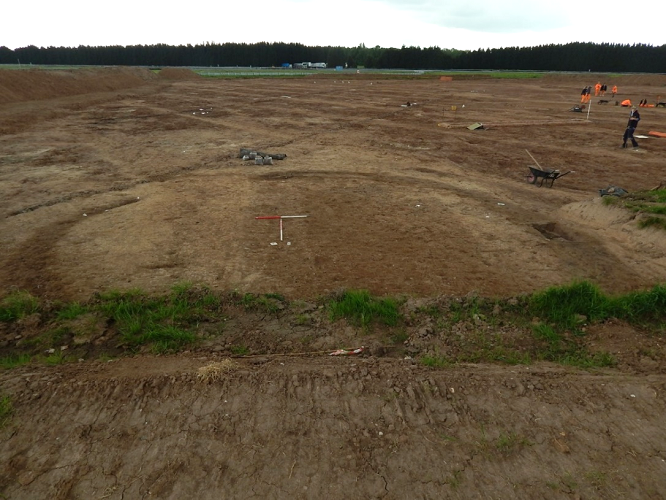
Due to the extensive remains uncovered, the area strip was enlarged. Within the extension a second pit alignment boundary was revealed, located on east side of the site. The second boundary was running in a NE to SW direction, and converges with the first NW to SE pit alignment. The first pit alignment appears to have a regular set of pits, whilst the second pit alignment has variable pit sizes and shapes. The second pit alignment was later cut by boundary ditches running along the same alignment. A small rectangular enclosure was also revealed attached the boundary ditch on the east side, along with further roundhouses and an area containing a dense number of large postholes. The latter, perhaps evidence for structures and/or fence lines for enclosures. Finds from the site included both Iron Age pottery and some animal bone. The excavations will continue into the early summer, with a particular focus on the converging pit alignments and their subsequent remodelling by later features.
IRCHESTER FIELD SCHOOL 2024 – GUIDED TOURS
The Irchester Field School is a collaborative community research project run as a partnership between the University of Leicester and North Northants Council and based at the Chester House Estate (https://chesterhouseestate.org/), a free to enter heritage site within which lies Irchester, one of the best preserved walled Roman small towns in Britain. In June and July, the University of Leicester’s School of Archaeology and Ancient History (SAAH) and University of Leicester Archaeological Services (ULAS) conduct archaeological excavations here in partnership with volunteers and staff from the Chester House Estate and its Archaeological Resource Centre. Tours of the site are now being offered comprising a guided tour of the excavations with a professional archaeologist; a tour of the Northamptonshire Archaeological Resource Centre with one of the curators, with an opportunity to see some of the highlights of the county’s archaeological discoveries; and a workshop run by a Roman specialist showcasing some of the finds from the excavations and what they can tell us about the town’s inhabitants. Each tour can accommodate 6 – 25 individuals, and will last approximately two hours 30 minutes. All tours start at 1400. For further details of costs, dates and bookings, see
https://shop.le.ac.uk/product-catalogue/events-at-leicester/heritage-hub/irchester-field-school-2024. If you would like to know more about the project, there is a short video at https://vimeo.com/onetoonedevelopment/review/887425947/d7866b4af5.
FORTHCOMING EVENTS
FESTIVAL OF LEICESTERSHIRE AND RUTLAND ARCHAEOLOGY
Saturday 29 June – Wednesday 31 July 2024
Archaeology is all about people and how we explore and interpret the past. Archaeology has a unique ability to bring people from all walks of life together through our shared sense of community – what it meant in the past, what it means to us now, and how we can shape our future. Celebrate the rich and diverse heritage of Leicestershire and Rutland, and uncover the stories, sites, buildings, places and people that make our local communities special. Go to new places and revisit old ones. Discover and share the history and archaeology that is all around us. The Festival will include events, guided walks and tours, talks and performances, exhibitions and displays, and hands-on excavations. Details of dates and activities can be found at Festival of Leicestershire and Rutland Archaeology – Leicestershire Fieldworkers (leicsfieldworkers.org) - click on the various headings. The Festival of Leicestershire and Rutland Archaeology is organised by Leicestershire Fieldworks as part of the CBA’s national Festival of Archaeology.
LEICESTER CATHEDRAL TOURS
Leicester Cathedral is offering tours on Thursday mornings on historical themes. These cover Cathedral Windows (first Thursday in the month); the Evolution of Medicine (second Thursday); Prayer and Pilgrimage (third Thursday); and Carved in Stone (fourth Thursday). The tours start at 11.30 am and last around 30 minutes. Richard III tours lasting around 40 minutes are also available at various times on Tuesdays, Wednesdays, Friday and Saturdays. All tours cost £3.50 per person, accompanied children under 16 free, and can be booked via Eventbrite or at the Cathedral Welcome Desk. Please note that tours are subject to change, so do check the Cathedral website at Summer What's On 2024 | Leicester Cathedral for up-to-date information. If you are unable to take part in a tour, an illustrated guidebook is available from the Cathedral for £3. This covers the exterior of the building, as well as its ambulatory, aisles, chapels and nave, and has a useful glossary.
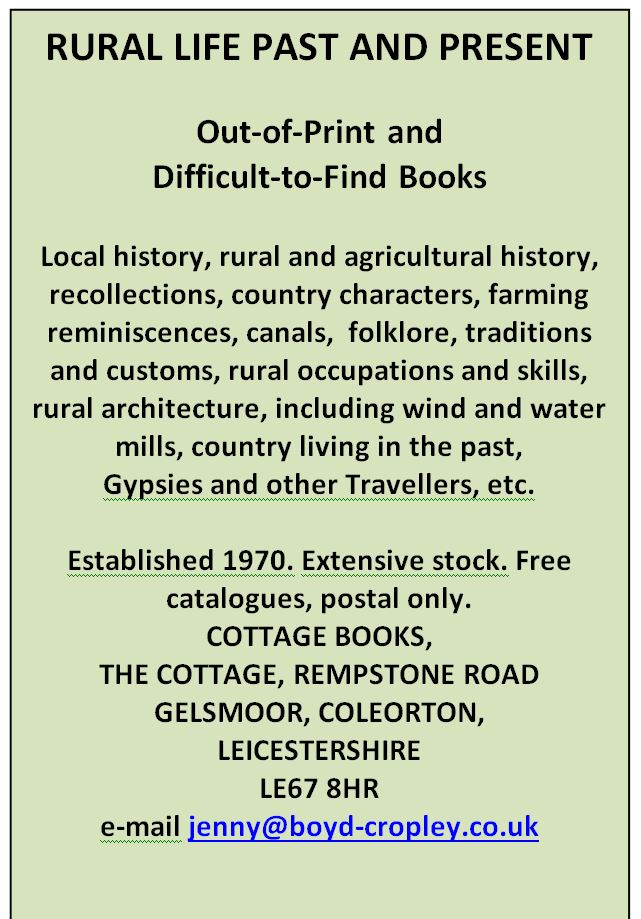
LEICESTER CIVIC SOCIETY
Saturday 22 June 2024, Secular Hall, Humberstone Gate, Leicester, LE1 1WB, 2pm for business meeting; talk at 3 pm
Annual General Meeting
Everyone is welcome. The keynote speaker, Grant Butterworth, Head of Planning at Leicester City Council, will be making a presentation about Leicester’s Waterside/Sock Island redevelopment. He will be comparing the Waterside and Wolsey developments, how properly funded municipal-led regeneration can be quicker and more cohesive than market-led delivery, and the Simpson Towers story. He will also consider the future of some of the remaining industrial buildings in the Frog Island area. If you would just like to attend the presentation, please arrive between 2.50 and 3 pm. Refreshments will be available.
Saturday 30 June 2024, 5 – 6.30 pm
Art Deco, Art Nouveau
Jim McCallum
As a growing town with its fair share of artistic people and wealth, often rather tucked away are excellent examples of the art deco and art nouveau styles that came to prominence in the 1920s and 30s. Join us for an early evening summer stroll through some of central Leicester seeking out often overlooked and ill-maintained examples of these mainly inter-war styles.
Saturday 10 August 2024, 10 am – 12.30 pm
Georgian Leicester walk
Mike Taylor
The walk starts from the courtyard of St Martin’s Square, LE1 5DG, and will go from there to the Museum, covering on the way as much as possible of buildings in central Leicester during the period 1714-1837.
Both walks cost £5 for members and £7 for non-members, and advance booking is essential. See All Events - Leicester Civic Society for more details and bookings.
LEICESTERSHIRE AND RUTLAND FAMILY HISTORY SOCIETY – LEICESTER GROUP
Wednesday 12 June 2024, Friends Meeting House, 16 Queen’s Road, Leicester, LE2 1WP
Archaeology After Richard III: 10 years of archaeological discoveries in Leicester
Mathew Morris
Wednesday 10 July 2024, Friends Meeting House, 16 Queen’s Road, Leicester, LE2 1WP
The History of New Walk
Mark Mitchley
For further details of these and meetings of LRFHS branches in Hinckley, Loughborough, Market Harborough and Oakham, see LRFHS - Meetings.
LEICESTERSHIRE FIELDWORKERS
Thursday 20 June 2024, 7.30pm, Rattray Lecture Theatre, University of Leicester, LE1 7RH, preceded by the Leicestershire Fieldworkers AGM at 6.45pm
How was Stonehenge built?
Mike Pitts
Freelance journalist and archaeologist Mike Pitts addresses the question few archaeologists have asked until now: how was Stonehenge built? This takes us into new and unexpected areas, as we enter the real world of people confronting social and engineering challenges on a scale unprecedented for the place and time, over four 4000 years ago. Mike’s book on the subject was described by the Sunday Times as “a gripping archaeological detective story”. Entry is free an everyone is welcome. No booking necessary. Doors open from 6.30pm.
All welcome; free entry. Details of the autumn 2024 programmes are now available at Talks Programme – Leicestershire Fieldworkers (leicsfieldworkers.org).
MARKET HARBOROUGH HISTORICAL SOCIETY
11 September 2024, 7.30 pm, Methodist Church, Northampton Rd, Market Harborough
The Archaeology of Gumley and Laughton
Bob Gale
Bob Gale a keen amateur archaeologist, is the chairman of Oadby and Wigston Fieldworkers. This group has done much exploration of local villages including Laughton, Mowsley, Smeeton Westerby and Gumley working with the University of Leicester and the Hallaton fieldworkers. In this talk Bob will talk about what they have discovered about the villages of Laughton and Gumley, the latter known for its Mercian roots. Doors open 7 pm. All are welcome. There is a £1 door charge to help with room hire. Non-members pay an additional £3. Further details of the Society’s 2024 – 25 programme are now available at Market Harborough Historical Society - Programme
NEWARKE HOUSES MUSEUM AND GARDENS, THE NEWARKE, LEICESTER, LE2 7BY
Sunday 16 June 2024, 2 pm
Charnwood Street Shops
Cynthia Brown
Following her sold out talk in January we welcome back local historian Cynthia Brown for an illustrated talk that will revisit the Charnwood Street area of Leicester and explore local memories of its many shops. They include the ‘Aladdin’s Cave’ of Paddy’s Swag Shop and the first ever Wilkinson’s, opened in the 1930s. £6.00 charge for talk; refreshments included. Book online at Event Details – Leicester Museums, or through Newarke Houses Reception on 0116 225 4980.
WOLDS HISTORICAL ORGANISATION
Tuesday 18 June 2023, 7.45 pm
Jubilee Room, Wymeswold Memorial Hall, Clay Street, Wymeswold, LE12 6TY
The Melton and Oakham Navigation
Mick Clowes
Non-members welcome for a £3 contribution. There is a lift to the Jubilee Room.
NATIONAL TRUST OCTAVIA HILL LECTURE – AVAILABLE ONLINE
The National Trust Octavia Hill lecture given in March 2024 by Professor Mary Beard on the topic of ‘Who owns the past?’ is now available online at Octavia Hill Lecture | National Trust.
RECENT PUBLICATIONS
THE ANGLO-SAXON SETTLEMENT AT EYE KETTLEBY, LEICESTERSHIRE: LEICESTER ARCHAEOLOGY MONOGRAPH 27
Gavin Speed and Neil Finn
University of Leicester Archaeological Services, 2024, 163pp, illus, ISBN 9780957479289, £25
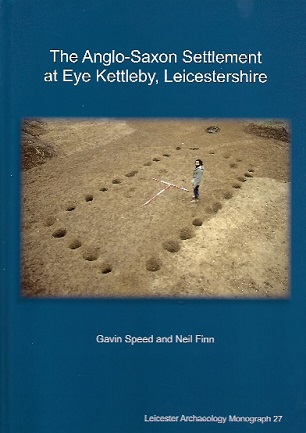
In the mid-1990s an almost complete early Anglo-Saxon settlement was excavated by the University of Leicester Archaeological Services (ULAS) at Eye Kettleby, in the Wreake Valley close to Melton Mowbray. This was the largest such settlement excavated in the region, and remains one of only a few of similar size of its type in England. The results of this excavation have now been published, combining the evidence it revealed with a close analysis and discussion of the site and its development. As Gavin Speed, one of its authors notes: ‘The Dark Ages is a period poorly understood, due to the near absence of written records. Archaeological evidence is therefore of the utmost importance, although the archaeological remains do not often survive well…’. The book provides very detailed accounts of these remains, and places them within the wider landscape.
The opening chapter focuses on the background to the excavations, which were undertaken in response to proposals to construct a number of buildings and roads on the site. An initial fieldwalking survey suggested its potential as an early Anglo-Saxon settlement, and informed the excavation strategy described here. This is followed by extensive analysis of the settlement itself, comprising the remains of 28 post-built structures (PBSs), some or all of the larger ones being identified as houses, along with around 30 sunken-featured buildings (SFBs), 12 fire-pits and some 60 further pits, boundaries and fences. These are all catalogued in detail, with accompanying photographs, figures and tables. Evidence of material culture from the site is also considered in detail, while analysis of skeletal animal remains concludes that the settlement was a self-sufficient community, dependent on food and other resources produced by mixed farming. There is also evidence of activities such as ironworking, weaving and butchery, and possibly of special feasts or ritual meals. The final chapters of the book consider the significance and place of the settlement in the regional landscape, and the wider archaeological context of that at Eye Kettleby.
A HISTORY OF MARKET HARBOROUGH, VOLUME 2: FROM 1800 TO THE PRESENT
David Holmes ed.; Pam Aucott and Dudley Brown, assistant eds.
Market Harborough Historical Society, 2024, 344pp, illus, ISBN 9781739874711, £17
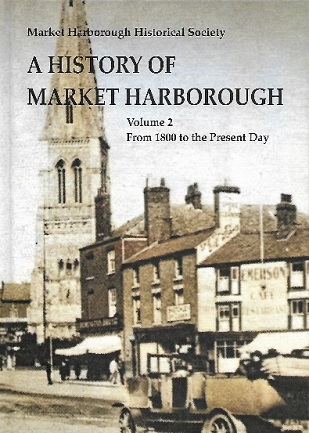
This history of Market Harborough from 1800 to the present is in every way a worthy successor to Volume 1 (reprinted 2024), which covered the earliest origins of the town through to the 18th century. Like its predecessor it incorporates contributions from a range of researchers, but these have been edited into thematic chapters rather than presented as individual essays. The book begins with an overview of the development of Market Harborough since 1800, in the form of maps and the buildings that contributed to or reflected this development. The coming of the Grand Union Canal in 1809 and the railway in 1850, both important prompts to growth, naturally feature prominently, along with the factories of W. Symington and R. and W.H. Symington Ltd, public buildings such as the Market Harborough Union Workhouse and the extent and direction of residential development, set in the context of population growth.
Other chapters deal with local administration, health services, public utilities, and education, illustrating the crucial role of voluntary organisations as well as the eventual assumption of more and more services by local government. Changes in religious belief and practice are also analysed, not least within the Church of England, which had to accommodate the full spectrum of 19th century Anglicanism as well as the strong challenge of Nonconformity. The chapter on changes in farming practices emphasises the close links between agriculture and Harborough’s economy, while another charts the growth of industry in the town, the diversity of which – including carpet-making, brewing, printing and publishing - may come as a surprise to some readers. There is much more besides, alongside brief biographies of some notable people associated with Harborough, a helpful timeline and extensive bibliography; but it is to be recommended above all as a very accessible, informative and beautifully illustrated account of Harborough over more than two centuries of change and development that could hardly have been envisaged in 1800. The book is available from Quinns bookshop, Market Harborough; Kibworth Books, Kibworth; Waterstones, Market Harborough; Historical Society meetings; and Harborough Library.
* Full reviews of the above publications will appear in the 2024 edition of the Leicestershire Historian.
CHARACTERISTICS OF THE CLERGY: THE ANGLICAN EXPERIENCE IN THE LATE-VICTORIAN TRANSITION IN LEICESTERSHIRE
Dave Fogg Postles
The Author, 2024, 52pp, illus, free PDF available at clergy.dvi (davelinux.info)
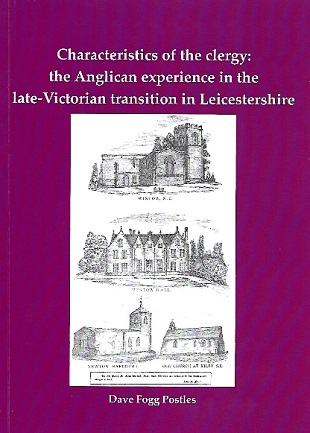
As this study demonstrates, patronage – the right to appoint or present a clergyman to a benefice – not only persisted into the 19th century, but posed something of an obstacle to the efforts of the Anglican church to counter the expansion of Nonconformity in the late-Victorian period. In 1874 William Connor Magee, Bishop of the Diocese of Peterborough which encompassed the archdeaconry of Leicester, expressed his ‘hate’ of the practice: ‘the most anxious, thankless and disappointing duty that any man can be called upon to perform. He is certain to disappoint nineteen out of twenty eligible men, and then it is twenty to one that the twentieth disappoints him’.
The analysis draws on Clergy List of 1852, supplemented by Crockford’s Clerical Directory for 1860, to analyse the distribution of patronage across Leicestershire, the number of livings appropriated to one person, the nature and value of the livings, and their significance in terms of wider family or social relationships, not least with their parishioners. The origins of the clergy varied considerably. While patronage influenced some ‘circular migration’ – from place of birth to university and back to place of birth - the majority of clergy migrated some distance from their original homes due to a need for ‘clerical mobility’. There were significant disparities in their wealth, as computed from the assessed value of their estates at death – although these may be more representative of their origins and status before entering the Church than the income from their benefices. In terms of politics many were openly committed to the Conservative cause, influenced to some degree, it seems clear, by the patrons of their livings. There are also many examples of the influence of individual clergy themselves in local government, education and in establishing the Leicestershire Architectural and Archaeological Society, the forerunner of LAHS. The book is available free online at the above address, and the author also has a small number of hard copies available. Please contact the Newsletter editor for more information. Dave Postles also has a blog based on the book at The persistence of patronage and the composition of the Anglican Clergy in the Archdeaconry of Leicester, c.1850-1903 - LAHS, with ‘anecdotal references’ and excellent images.
ADDITIONAL DONATIONS TO THE LIBRARY FROM LAHS MEMBER JAN ZIENTEK
LAHS member Jan Zientek has recently donated a large number of illustrated booklets to the LAHS Library, compiled from his extensive research into a range of subjects. Some of these, mainly relating to St Mary’s church in Humberstone, were listed in ‘News from the Library’ in the Spring 2024 edition of the Newsletter, and will be reviewed in this year’s edition of the Leicestershire Historian. The most recent donations consist of two separate series and one volume on the Leicester Brewing and Malting Company and some of its inns. Along with a history of the company, this has images and commentary on many of the latter.

A series of 18 booklets comprising high quality photographs and other images follows the route of the Great Central Railway London Extension south from Nottingham Victoria to Marylebone (the first 11), and the remainder other parts of the Great Central which were in use at that time . Each volume also provides historical context about the relevant section of the line, offering a comprehensive and invaluable record of the railway’s development encompassing rolling stock, stations and other buildings, bridges and remains of signals and other mechanisms. The second series, A Few Leaves from Launde Abbey, offers a selection of articles from Launde Leaves, the newsletter of the Friends of the Leicester Diocesan Retreat House at Launde Abbey in East Leicestershire. These cover the period from 1988 to 2023, and provide insights into the history of Launde, its activities, and the people responsible for its development and day to day management as well as its spiritual role. We are very grateful to Jan for his generosity in making his research available to LAHS members. A full list of the above volumes will appear in ‘News from the Library’ in the Autumn 2024 Newsletter.
A HISTORICAL FOOTNOTE
The holiday season is now upon us, and Skegness and other East Coast resorts remain popular destinations for people from Leicester and the county. Much of Skegness was owned by the Earl of Scarborough, and the arrival of the railway in 1873 prompted him to invest in transforming the town into a popular resort for day trips and holidays. From 1882 it was accessible by train from Leicester from the Great Northern railway station on Belgrave Road. Here is a flavour of the attractions of Skegness in 1933 from Kelly’s Directory of Lincolnshire.
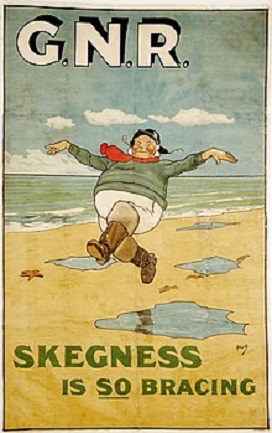
‘Skegness is a popular bathing place, town and parish, pleasantly situated on the coast of the North Sea, with a coastguard station… the sands are firm and extensive and the bathing safe. The streets are broad and well paved; a sea wall has been erected forming a promenade, and an excellent system of drainage has been completed… The Pier, erected at a cost of upwards of £22,000 by a Limited Company, was opened in May 1881, and is constructed of iron, the length being 1,843 feet, with a saloon to seat 600 people… There are seven hotels and numerous boarding and lodging houses. The Pleasure Gardens, near the North parade, are about 6 acres in extent, well provided with seats for visitors, and contain a pavilion holding over 1,000 persons. The Clock Tower, facing the sea, at the end of Lumley road, was erected to commemorate the Diamond Jubilee of her Majesty Queen Victoria.
‘There are Cricket and Lawn Tennis Grounds near the station, about 9 acres in extent. The Marine Gardens extend along the front of the North and South parades, and include a boating lake and covered shelter for 200 people; in the centre of the gardens, facing the North parade, is an ornamental fountain… The Public Baths, in Scarborough avenue, erected in 1882, comprise ladies’ and gentlemen’s swimming baths and private baths. A bathing pool and piazza was erected in 1928 at a cost of £30,000… the phosphorescence of the sea here is very beautiful, and may be frequently observed in the summer. The shore is composed of fine sand extending for miles to the north and south of the town. The National Lifeboat Institution have a station here…’
It is to be hoped that railway travel to the East Coast was relatively tranquil by the 1930s, compared with a description of Bank Holiday excursions in the Leicester Journal in August 1885. Passengers were reported to be ‘fighting to get a position on the train’, and ‘the pleasure of a very large per-centage of the passengers is marred for the day through some angry words, and even blows, that are given in these struggles to obtain seats in the trains. And it frequently happens that passengers who have annoyed each other in this manner have to be penned up in the same compartment for the whole of their journey…’ (7 August 1885).
Image: Great Northern Railway ‘Jolly Fisherman’ poster 1908 (public domain)
This newsletter is edited by Cynthia Brown and published by Leicestershire Archaeological and Historical Society. Further information about the Society, its publications and other activities can be found on its website at www.lahs.org.uk.
Background image: Iron Age roundhouse at MIRA Drive, Lindley, © ULAS (2024)
Iron Age roundhouse at MIRA Drive, Lindley, © ULAS (2024)



